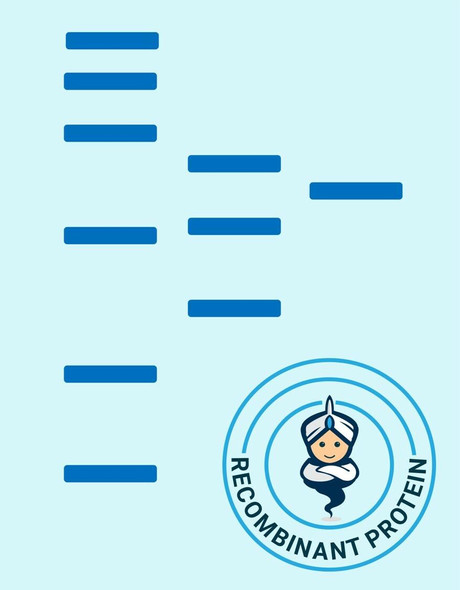Description
| Product Name: | Human H2AFZ Recombinant Protein |
| Product Code: | RPPB3653 |
| Size: | 10µg |
| Species: | Human |
| Target: | H2AFZ |
| Synonyms: | H2A Histone Family, Member Z, H2AZ, H2A/z, H2A.Z-1, H2A.z,H2AZ Histone, Histone H2A.Z. |
| Source: | Escherichia Coli |
| Physical Appearance: | Sterile Filtered clear solution. |
| Formulation: | H2AFZ protein solution (0.25mg/ml) containing 20mMTris-HCl buffer (pH 8.0), 0.4M Urea and 10% glycerol. |
| Stability: | Store at 4°C if entire vial will be used within 2-4 weeks. Store, frozen at -20°C for longer periods of time.For long term storage it is recommended to add a carrier protein (0.1% HSA or BSA).Please avoid freeze thaw cycles. |
| Purity: | Greaterthan 85% as determined by SDS-PAGE. |
| Amino Acid Sequence: | MGSSHHHHHH SSGLVPRGSH MGSMAGGKAG KDSGKAKTKA VSRSQRAGLQ FPVGRIHRHL KSRTTSHGRVGATAAVYSAA ILEYLTAEVL ELAGNASKDL KVKRITPRHL QLAIRGDEEL DSLIKATIAG GGVIPHIHKSLIGKKGQQKT V |
HistoneH2A.Z (H2AFZ) belongs to the histone H2A family. Histones are basic nuclearproteins which are responsible for the nucleosome structure of the chromosomalfiber in eukaryotes. Nucleosomes consist of approximately 146 bp of DNA wrappedaround a histone octamer composed of pairs of each of the four core histones(H2A, H2B, H3, and H4). H2AFZ is implicated in the formation of constitutiveheterochromatin and vital for chromosome segregation during cell division.Moreover, variant Histone H2A, which takes the place of conventional H2A in asubset of nucleosomes. Studies in mice have demonstrated that this particularhistone is essential for embryonic development and show that lack of functionalhistone H2A leads to embryonic lethality.
H2AFZ Human Recombinant produced in E.Coli is a single,non-glycosylated polypeptide chain containing 151 amino acids (1-128 a.a) andhaving a molecular mass of 15.9kDa.H2AFZ is fused to a 23 amino acid His-tag at N-terminus& purified by proprietary chromatographic techniques.
| UniProt Protein Function: | H2AZ: Variant histone H2A which replaces conventional H2A in a subset of nucleosomes. Nucleosomes wrap and compact DNA into chromatin, limiting DNA accessibility to the cellular machineries which require DNA as a template. Histones thereby play a central role in transcription regulation, DNA repair, DNA replication and chromosomal stability. DNA accessibility is regulated via a complex set of post-translational modifications of histones, also called histone code, and nucleosome remodeling. May be involved in the formation of constitutive heterochromatin. May be required for chromosome segregation during cell division. The nucleosome is a histone octamer containing two molecules each of H2A, H2B, H3 and H4 assembled in one H3-H4 heterotetramer and two H2A-H2B heterodimers. The octamer wraps approximately 147 bp of DNA. H2A or its variant H2AFZ forms an heterodimer with H2B. H2AFZ interacts with INCENP. Belongs to the histone H2A family. |
| UniProt Protein Details: | Protein type:DNA-binding Chromosomal Location of Human Ortholog: 4q23 Cellular Component: Barr body; nuclear heterochromatin; nucleus Molecular Function:chromatin DNA binding; nucleosomal DNA binding; protein binding Biological Process: chromatin silencing; positive regulation of transcription from RNA polymerase II promoter |
| NCBI Summary: | Histones are basic nuclear proteins that are responsible for the nucleosome structure of the chromosomal fiber in eukaryotes. Nucleosomes consist of approximately 146 bp of DNA wrapped around a histone octamer composed of pairs of each of the four core histones (H2A, H2B, H3, and H4). The chromatin fiber is further compacted through the interaction of a linker histone, H1, with the DNA between the nucleosomes to form higher order chromatin structures. This gene encodes a replication-independent member of the histone H2A family that is distinct from other members of the family. Studies in mice have shown that this particular histone is required for embryonic development and indicate that lack of functional histone H2A leads to embryonic lethality. [provided by RefSeq, Jul 2008] |
| UniProt Code: | P0C0S5 |
| NCBI GenInfo Identifier: | 83288408 |
| NCBI Gene ID: | 3015 |
| NCBI Accession: | P0C0S5.2 |
| UniProt Secondary Accession: | P0C0S5,P17317, Q6I9U0, B2RD56, |
| UniProt Related Accession: | P0C0S5 |
| Molecular Weight: | 14kDa |
| NCBI Full Name: | Histone H2A.Z |
| NCBI Synonym Full Names: | H2A histone family member Z |
| NCBI Official Symbol: | H2AFZ�� |
| NCBI Official Synonym Symbols: | H2AZ; H2A.z; H2A/z; H2A.Z-1�� |
| NCBI Protein Information: | histone H2A.Z |
| UniProt Protein Name: | Histone H2A.Z |
| UniProt Gene Name: | H2AFZ�� |






